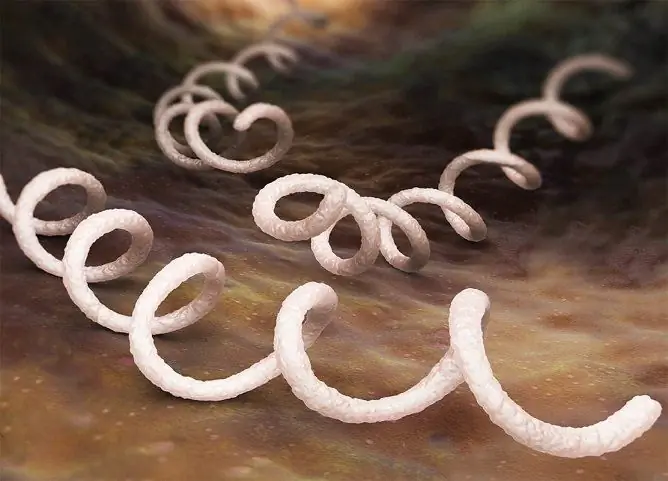- Author Rachel Wainwright [email protected].
- Public 2023-12-15 07:39.
- Last modified 2025-11-02 20:14.
Syphilis in women
The content of the article:
- Causes and risk factors
- Forms of the disease
- Disease stages
- Symptoms of syphilis in women
- Diagnostics
- Treatment
- Possible complications and consequences
- Forecast
- Prevention
Syphilis in women is a sexually transmitted disease, which is characterized by a long progressive course with damage to all body systems and the likelihood of developing serious complications.

Treponema pale - the causative agent of syphilis
Due to the emergence of highly effective antibacterial drugs, preventive examination of persons at risk and pregnant women, the overall incidence rate has been reduced. At the same time, there is an increase in the number of patients with syphilis in certain groups - among socially disadvantaged persons, prisoners, etc. Syphilis still occupies a leading position in the general structure of sexually transmitted infections, in terms of contagiousness and degree of harm to health.
Causes and risk factors
The causative agent of syphilis is pale treponema (Treponema pallidum), which has the form of a curved spiral with internal flagella. Treponema pale was discovered in 1905 by German microbiologists Erich Hoffmann and Fritz Schaudin. All known subspecies of this bacterium are pathogenic for humans. The most favorable environment for the reproduction of pale treponema are lymphatic vessels and lymph nodes. The microorganism is capable of penetration through the intercellular junctions of the endothelium. Pale treponema persists for a long time in a warm and humid environment, is quite resistant to low temperatures. In the external environment, it is unstable, dies when drying, heating (at 55 ˚С - after 15 minutes, at 100 --С - instantly), the action of disinfectants. Due to the unreasonable use of antibiotic therapy, treponema pale has acquired resistance to many antibiotics.
Patients with syphilis are contagious at any stage, especially during primary and secondary syphilis, which are accompanied by cutaneous manifestations. The main route of transmission is sexual. In addition, infection can occur through household contact, with blood transfusions, in utero (infection of the fetus by a sick mother), through breast milk.

Syphilis infection occurs primarily through sexual contact.
The risk group includes medical workers, as well as socially disadvantaged people, primarily injecting drug users, persons employed in the provision of intimate services and prisoners. However, given the possibility of the domestic transmission route, no one is immune from the disease.
Forms of the disease
Syphilis is classified as follows:
- congenital (early and late);
- acquired (typical and atypical).
Atypical, in turn, can be of the following forms:
- erased - proceeds imperceptibly, almost asymptomatic in the secondary period, manifests itself as damage to the nervous system (neurosyphilis) at a late stage;
- transfusion - characteristic of the transfusion route of transmission (with contaminated blood transfusion), characterized by the absence of primary manifestations, the first signs are already secondary syphilis, appears 2-2.5 months after blood transfusion;
- malignant - characterized by pronounced manifestations, severe course, exhaustion, frequent accession of a secondary infection.
Disease stages
In the clinical picture of syphilis, the following stages are distinguished:
- incubation period;
- primary syphilis;
- secondary syphilis (divided into fresh, recurrent and latent);
- tertiary syphilis (subdivided into neurosyphilis and visceral, in which internal organs are affected).
Symptoms of syphilis in women
The presence of certain signs of syphilis in women depends on the stage of the disease.
The incubation period is usually about three weeks from the time of infection, but in some cases it can last up to three months.

Symptoms of syphilis in women
At the stage of primary syphilis in women, a hard chancre is formed at the site of infection, which is a dense inflammatory infiltrate with slightly raised edges and ulceration in the middle ranging from 3-4 mm to 4-5 cm. As a rule, the formation of a hard chancre is not accompanied by pain, but in some cases it can be mildly painful. Hard chancres in women are most often formed on the mucous membrane of the vulva or vagina, mouth, and also on the skin near the external genitalia or in the perianal region. However, taking into account the everyday transmission route, chancre can form on other parts of the body. When a hard chancre forms on the mucous membrane of the vagina or cervix, it often goes unnoticed. When a hard chancre occurs on the tonsils, the clinical picture resembles a sore throat. Chancre is often single, but there are multiple lesions.
As the disease progresses, the chancre does not grow, but it also does not respond to local treatment with antiseptic drugs. A week and a half after its appearance, the lymph nodes closest to it increase, reaching in some cases the size of a chicken egg. The enlargement of lymph nodes is often unilateral, but it can also be bilateral. Even in the absence of therapy, hard chancres disappear after a month and a half, as a rule, there are no scars after them (unless there was an extensive ulcer). Large chancres can leave behind areas of hyperpigmentation. Towards the end of the stage of primary syphilis, women feel worse, sleep disorders, joint and muscle pain are observed. The primary period ends with the disappearance of the hard chancre, and the disease passes into the next stage.

Chancre with syphilis
Secondary syphilis is characterized by skin rashes, the so-called syphilis, appearing 4-10 weeks after the formation of a hard chancre. The rash is located throughout the body, including the palms and soles, as well as on the mucous membranes, and is characterized by polymorphism. The rash does not cause itching or other changes in skin sensitivity, and its appearance is not accompanied by a deterioration in the general condition.
Syphilitic roseola, the most common form of rashes (up to 80%), look like pale pink, rounded spots that do not rise above the surface of the skin and do not flake. When pressed, the roseola fade and disappear, then reappear. Papular rash looks like nodular neoplasms of a rounded shape, bright pink in color with a cyanotic shade. Papules among themselves with the formation of plaques. On palpation of papules, sharp pain may occur. The pustular rash resembles acne or chickenpox. The pustules are covered with crusts or scales, inside they contain purulent exudate, after they resolve, scars remain on the skin. Also, syphilis can have the appearance of ulceration or warts.
Skin rashes usually appear paroxysmal. With the development of repeated rashes, the primary and secondary elements of the rash are different - the secondary ones are lighter, less abundant, but larger and tend to merge. The frequency of relapses depends on the state of the immune system. A rash with secondary syphilis in women resolves after 2-12 weeks, usually without leaving marks (occasionally, a change in skin color may occur at the site of resolved syphilis).
Leucoderma also belongs to the cutaneous manifestation of syphilis, that is, white spots are areas of the skin with loss of pigmentation. Most often, leukoderma occurs on the neck, forming the so-called necklace of Venus - one of the specific symptoms of secondary syphilis. In addition, spots can form on the chest, neck, abdomen, underarms, back and lower back. Leucoderma persists for a long time even during treatment.

Leucoderma refers to the cutaneous manifestations of syphilis in women
Alopecia areata, or alopecia areata, is another characteristic symptom of secondary syphilis, which is especially noticeable in women. It represents areas of hair loss on the head, eyebrows, eyelashes. Less often, alopecia is of a generalized nature, in this case all hair falls out. Hair grows back a few months after starting treatment.
The stage of secondary syphilis in women is often accompanied by a sore throat, headaches, stiff neck muscles, visual and / or hearing impairments, paralysis and paresis, irritability, feeling of weakness and / or discomfort. Body temperature sometimes rises to subfebrile values, and a noticeable decrease in body weight may occur. In some cases, syphilitic tonsillitis develops, manifested by pronounced hyperemia of the tonsils, whitish spots on the surface of the tonsils, seizures in the corners of the mouth, the appearance of ulceration on the oral mucosa. Often there is a lesion of the vocal cords, which is manifested by a hoarse voice. A characteristic manifestation of secondary syphilis is generalized lymphadenitis, while the lymph nodes are painless.
In the absence of therapy, the disease turns into a latent form, in which there are no clinical signs of the pathological process. The latent period of syphilis in women can last from a year to several decades. In 20-30% of cases, the latent stage proceeds with periods of remission and exacerbations, during which signs of secondary syphilis (rash, etc.) appear again. Patients become contagious during periods of exacerbation.
Tertiary syphilis develops after a long time, it is caused by the transformation of pale treponemes into cysts and L-forms. During this period, damage to internal organs occurs. The clinical picture depends on which organs will be affected. These can be pathologies of the cardiovascular system (syphilitic aortitis, myocarditis), the nervous system (meningitis, neuritis, neuralgia, paresis, paralysis, epileptic seizures), syphilitic gastritis, hepatitis, nephritis, osteoarthritis, synovitis, as well as blindness, late syphilis (gum), which lead to irreversible destruction of tissues, including the tissues of the skull, with the formation of open and closed defects and rough scars.
Diagnostics
Diagnosis of syphilis consists in identifying its causative agent. Identification is carried out by the methods of polymerase chain reaction, passive hemagglutination reaction, immunofluorescence reaction, immobilization reaction of pale treponema, Wasserman reaction, as well as during microscopy of the serous contents of the chancre, elements of the rash (depending on the stage of the disease).

One of the methods for identifying the causative agent of syphilis in the body is the polymerase chain reaction
Treatment
The main goals of therapy are to eliminate the infectious agent, prevent the development of complications and infect other people. Treatment of syphilis is usually carried out in a hospital setting and consists in the use of antibacterial drugs: water-soluble penicillins, and, if they are ineffective, macrolides, fluoroquinolones or tetracyclines. The period of pregnancy is not a contraindication to antibiotic therapy for syphilis, since the disease can have serious consequences for the unborn child or cause miscarriage, as well as stillbirth. Antibiotic therapy is effective at all stages of the development of the disease and can prevent the development of serious complications from the internal organs at the stage of tertiary syphilis in women.
In the later stages, the main treatment can be supplemented by the appointment of iodine, bismuth, biogenic stimulants, immunotherapy, and physiotherapy.

Syphilis in women is treated with antibiotics
After completing the course, dispensary observation is shown. To control the cure, it is necessary to conduct repeated laboratory tests at regular intervals.
It is necessary to establish all the sexual partners of a woman and their preventive treatment, since syphilis is highly contagious during sexual transmission.
Possible complications and consequences
The lack of adequate treatment for syphilis in women can cause the development of infertility, disability, and death.
Infection of a fetus by a sick woman during pregnancy is fraught with the development of congenital syphilis in the child, with severe pathologies characteristic of this type of disease (congenital deafness, dental hypoplasia, interstitial keratitis, etc.), as well as possible death.
Forecast
Acquired syphilis in women responds well to therapy. Provided timely treatment, the prognosis is favorable, it decreases with an advanced form of the disease (irreversible disorders from the internal organs may develop), with resistance to the therapy.
Prevention
Prevention of syphilis in women consists in the following measures:
- careful adherence to the rules of personal hygiene, refusal to share toothbrushes, towels, etc.;
- refusal of casual and promiscuous sexual intercourse;
- condom use;
- strengthening immunity.
Preventive diagnosis of syphilis in women at risk, as well as in all pregnant women, donors and hospital patients, is required.
YouTube video related to the article:

Anna Aksenova Medical journalist About the author
Education: 2004-2007 "First Kiev Medical College" specialty "Laboratory Diagnostics".
The information is generalized and provided for informational purposes only. At the first sign of illness, see your doctor. Self-medication is hazardous to health!






